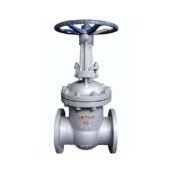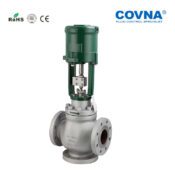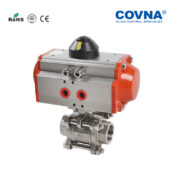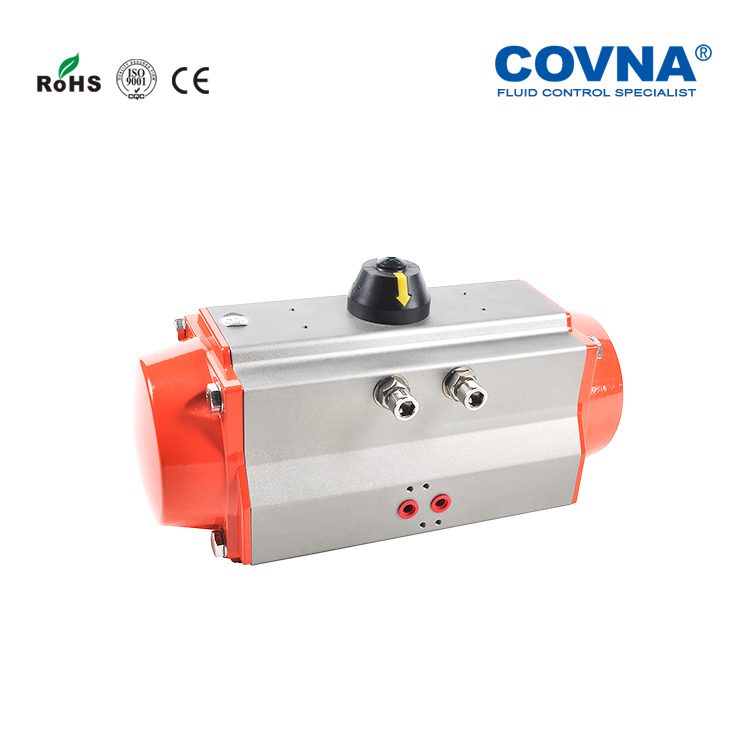
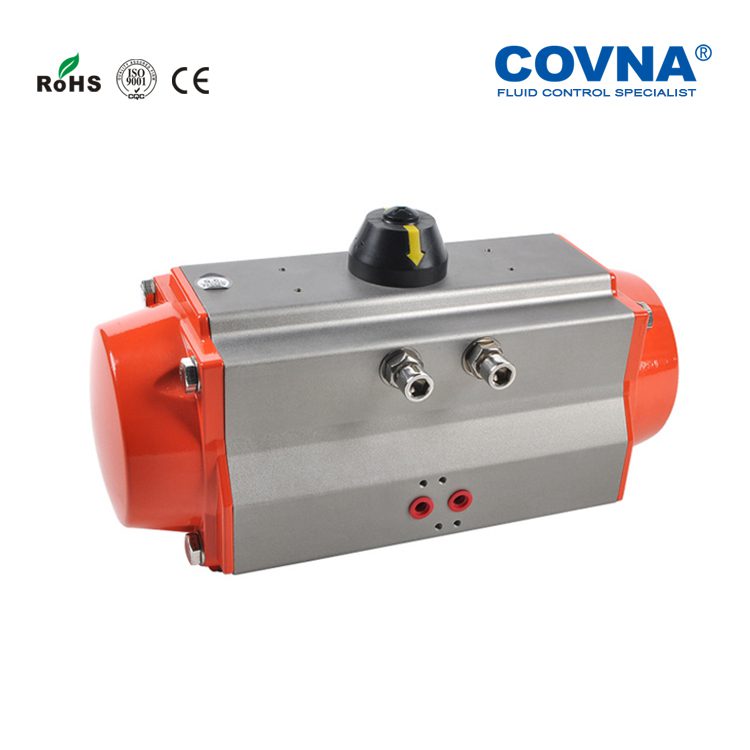
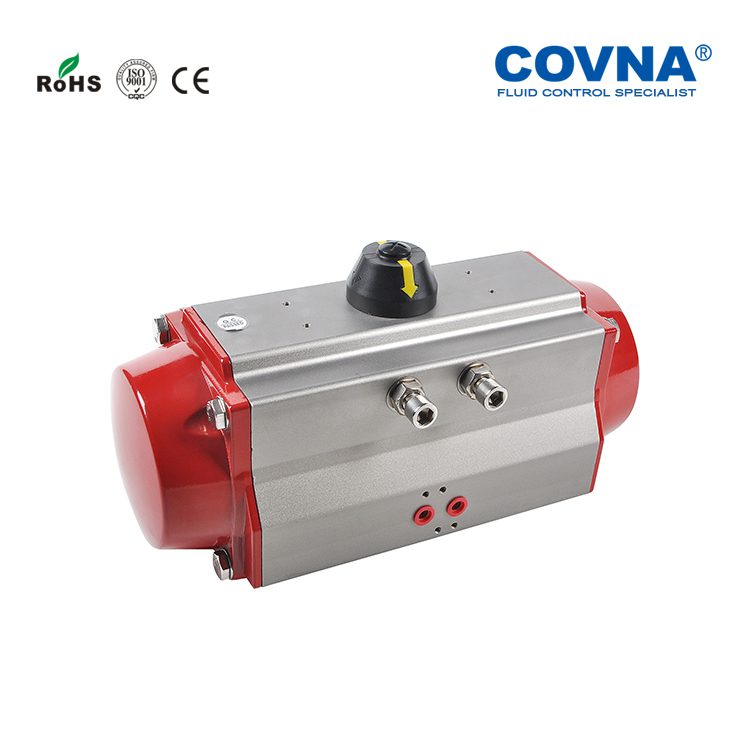
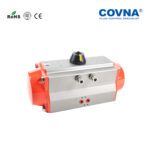

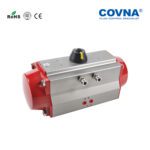
COVNA AT56 Spring Return Pneumatic Actuator
Spring Return Pneumatic Actuator with rack and pinion construction. Air to open and interrupt to close. Air supply power range from 2 bar to 8 bar. Output range from 5.7Nm to 2792Nm.
COVNA manufactures pneumatic actuators in spring return and double-acting types for different actuation.
Consult us to help you choose the right actuator!
Model
Actuator Type: Spring Return
Air Supply Pressure: 2.5 bar to 8 bar
Material: Aluminum alloy
Angle Of Rotation : 0° to 90°
Ambient Temperature: -40 to 160℃
Protection Class: IP65
Features of Spring Return Pneumatic Actuators:
● Spring return pneumatic actuator with feature of safe
● Rack and pinion pneumatic actuator with high output torque
● Easy to install and change the number of spring
● Weather-proof
Working Principle Of Spring Return Pneumatic Actuators:
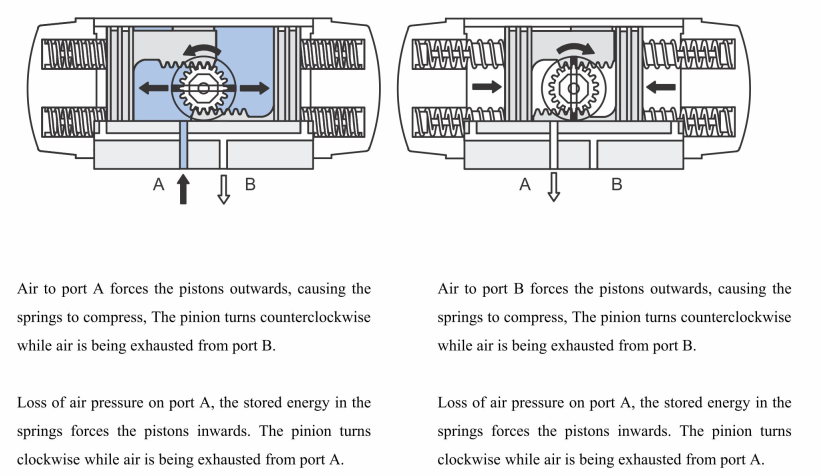
Dimension:

| Actuator Type | Double Acting |
|---|---|
| Pressure Range | 2 to 7bar |
| Temperature Range | 20°C to 80°C |
| Bottom Mounting Connection | ISO 5211/DIN 3337 |
| Rotation | 90° |
| Lifespan | 1,000,000 Times Rotation |
1.Oil and Gas Industry
Pipeline Flow and Pressure Control: Used for flow and pressure control in natural gas and oil pipelines to ensure stability during transportation.
Gas and Liquid Distribution Systems: Regulates the flow of gases or liquids, ensuring precise control under various operating conditions.
Automation of Distribution Systems: Used in refineries and natural gas processing plants to automate fluid distribution and regulate the reaction processes.
2.Chemical and Petrochemical Industry
Reactor Pressure and Flow Control: Used in chemical reactors, storage tanks, and other equipment to control pressure and flow, ensuring stability in the chemical reaction process.
Flow/Pressure Regulation: Regulates the flow of liquids or gases in processes such as polymerization, refining, and distillation to ensure efficient production.
Steam Control: Regulates the flow and pressure of steam in steam generators and distribution systems.
3.Water and Wastewater Treatment
Water Flow Control: Regulates water flow and pressure in water supply and wastewater treatment systems to ensure normal operation.
Gas and Chemical Additions: Regulates the flow of chemicals or gases (such as chlorine or ammonia) added during the water treatment process.
4.HVAC (Heating, Ventilation, and Air Conditioning) Systems
Temperature Control and Airflow Regulation: Used in air conditioning systems to regulate the flow of cooling or heating fluids to maintain the desired temperature.
Pressure and Airflow Regulation: Adjusts the flow and pressure of air in ventilation, air conditioning, and humidification systems to ensure indoor comfort.
5.Food and Beverage Industry
Liquid Flow Control: Precisely controls the flow of liquids in processes such as brewing, dairy production, and beverage bottling.
Temperature and Pressure Regulation: Regulates temperature and pressure during heating, cooling, and sterilization to ensure product quality and safety.
6.Pharmaceutical Industry
Precision Flow Control: Regulates the flow of liquids and gases in pharmaceutical manufacturing processes to ensure precise control of process parameters.
Pressure Control: Adjusts pressure in cleaning and sterilization systems to ensure stable system operation.
7.HVAC Systems
Airflow and Temperature Control: Controls the flow and temperature of air to adjust environmental conditions, ensuring comfort and energy efficiency inside buildings.
8.Steel and Metallurgical Industry
Gas Flow Control: Precisely adjusts the flow of gases such as oxygen and nitrogen during smelting and heating processes to ensure stable furnace temperatures and chemical reactions.
Cooling Fluid Flow Regulation: Regulates the flow of cooling fluids in cooling systems to ensure temperature control of equipment.
9.Thermal and Power Industry
Steam and Water Flow and Pressure Control: Regulates the flow of steam and water in boiler systems, heat exchangers, and power plants to ensure efficient operation of thermal systems.
10.Mining Industry
Slurry Flow Regulation: Adjusts the flow and pressure of slurry during transportation and separation processes to ensure efficient extraction and processing of minerals.

